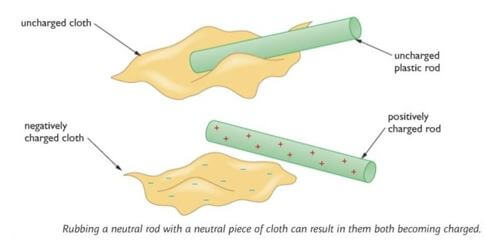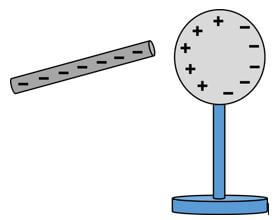- Static electricity
- Pollution control
- Safety measures when dealing with static charges
- Electrical Energy
- Magnetism

FORCE AND ENERGY
Static electricity
Static electricity is an imbalance of electric charges within or on the surface of a material or between materials.
A static electric charge can be created whenever two surfaces contact and have worn and separated, and at least one of the surfaces has a high resistance to electric current.
The effects of static electricity are familiar to most people because people can feel, hear, and even see the spark as the excess charge is neutralized when brought close to a large electrical conductor (for example, a path to ground), or a region with an excess charge of the opposite polarity (positive or negative)
Contact-induced charge
In high-school science demonstrations involving rubbing different materials together (e.g., fur against an acrylic rod). Contact-induced charge separation causes your hair to stand up and causes "static cling" (for example, a balloon rubbed against the hair becomes negatively charged; when near a wall, the charged balloon is attracted to positively charged particles in the wall, and can "cling" to it, appearing to be suspended against gravity).
There are two ways of charging objects
- rubbing
By using the method of friction, positive charge is developed on one of the bodies and negative charge on the other. When these two bodies are brought close, they attract.
Some objects have tendency to gain positive charge (example glass and ebonite rod) while some objects have the tendency to gain negative charge(example silk).
- Induction

When an uncharged object is placed very close to a charged conductor without touching, the nearer end acquires a charge opposite to the charge on the charged conductors and the two bodies attract. This is called charging by induction. The net charge on the bodies remains the same and body is charged until they are kept close or brought in contact.
Effects of force between charged objects
- Like charges repel each other; unlike charges attract. Thus, two negative charges repel one another, while a positive charge attracts a negative charge.
- The attraction or repulsion acts along the line between the two charges.
- Forces are exerted by charged objects. Two electrically charged objects can exert a force on each other without directly touching. This force is an example of a non-contact force.
- Forces can attract and repel. Two objects with the same type of charge will repel, whilst two oppositely charged objects attract. The force between unlike charges is called electrostatic attraction. The force between like charges is called electrostatic repulsion.
- Electrostatic forces can cause movement. Similar to other forces, electrostatic forces can cause movement. Electrostatic attraction causes objects to move closer together, whilst electrostatic repulsion causes objects to move further away from each other. If we think back to our example with the rod and the cloth, the positive rod will attract the negative cloth, so they will move closer together.
Uses of static charges
Although static electricity can be a nuisance—like getting shock when you touch a doorknob or having static cling on your clothes—it has a number of beneficial uses.
The forces of attraction between charged particles caused by static electricity are used in air pollution control, xerography and automobile painting.
Questions you may have include:
- How is static electricity used in air pollution control?
- How does a Xerox machine work?
- How is static electricity used to paint cars?
Static electricity is used in pollution control by applying a static charge to dirt particles in the air and then collecting those charged particles on a plate or collector of the opposite electrical charge. Such devices are often called electrostatic precipitators.
Factories use static electricity to reduce pollution coming from their smokestacks. They give the smoke an electric charge. When it passes by electrodes of the opposite charge, most of the smoke particles cling to the electrodes. This keeps the pollution from going out into the atmosphere.
Air fresheners
Some people purchase what are called air ionizers to freshen and purify the air in their homes. They work on a similar principle as the smokestack pollution control. These devices strip electrons from smoke molecules, dust particles, and pollen in the air, just as what happens in creating static electricity.
These charged dust and smoke particles are then attracted to and stick to a plate on the device with the opposite charge. After a while, much of the pollution is drawn from the air.
Since charged particles will also stick to neutral surfaces, some of them can stick to the wall near the ionizer, making it very dirty and difficult to clean.
Xerography
Your photocopier or Xerox machine uses static electricity to copy print to a page. This is done through the science of xerography.
One version of this device electrically charges ink so that it will stick to the paper in the designated areas. Another version of a photocopier uses charges to stick the ink to a drum, which then transfers it to the paper.
Painting cars
Some automobile manufacturers use static electricity to help them paint the cars they make. The way this works is that they first prepare the car's surface and then put it in a paint booth. Next, they give the paint an electrical charge and then spray a fine mist of paint into the booth. The charged paint particles are attracted to the car and stick to the body, just like a charged balloon sticks to a wall. Once the paint dries, it sticks much better to the car and is smoother because it is evenly distributed.
Safety measures when dealing with static charges
Use of the following in the workplace may be necessary to prevent charge accumulation that can lead to static electricity:
- nonmetal handrails
- insulated doorknobs
- nonconductive shields
- antistatic wrist straps
- static dissipating boots
- antistatic or conductive clothing
Electricity cannot be mined from the ground like coal. So it is called a secondary source of energy, meaning that it is derived from primary sources, including coal, natural gas, nuclear fission reactions, sunlight, wind, and hydropower. Most direct uses of primary energy are limited to generating heat and motion.
Electric circuit
When there are two or more electrical devices in a circuit with an energy source, there are a couple of basic ways by which we connect them. They can either be connected in series or in parallel combinations. A series circuit is a circuit in which two components share a common node and the same current flows through them. However, in a parallel circuit, components share two common nodes.
Series
A circuit is said to be connected in series when the same current flows through all the components in the circuit. In such circuits, the current has only one path. Let us consider the household decorative string lights as an example of a series circuit. This is nothing but a series of multiple tiny bulbs connected in series. If one bulb fuses, all the bulbs in the series do not light up.
Parrallel
A circuit is said to be parallel when the electric current has multiple paths to flow through. The components that are a part of the parallel circuits will have a constant voltage across all ends.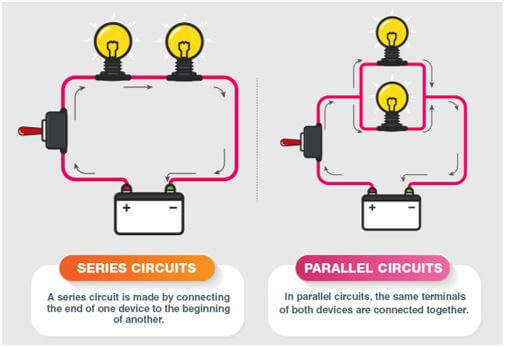
| Difference between series and parallel circuits | |
| Series | Parallel |
| The same amount of current flows through all the components | The current flowing through each component combines to form the current flow through the source. |
| In an electrical circuit, components are arranged in a line. | In an electrical circuit, components are arranged parallel to each other. |
| When resistors are put in a series circuit, the voltage across each resistor is different even though the current flow is the same through all of them. | When resistors are put in a parallel circuit , the voltage across each of the resistors is the same. even the polarities are the same. |
| If one component breaks down, the whole circuit will break down. | other components will function even if one of the components breaks down, each has its own independent circuit. |
| If Vt is the total voltage then it is equal to V1 + V2 + V3 | If Vt is the total voltage then it is equal to V1 = V2 = V3 |
The are two types
- conductors
- non-conductors
Applications of Conductors
Conductors are quite useful in many ways. They find use in many real-life applications. For example,
- Mercury is a common material in thermometer to check the temperature of the body.
- Aluminium finds its use in making foils to store food. It is also used in the production of fry pans to store heat quickly.
- Iron is a common material used in vehicle engine manufacturing to conduct heat.
- The plate of iron is made up of steel to absorb heat briskly.
- Conductors find their use in car radiators to eradicate heat away from the engine.
Applications of Insulators
As insulators resist the flow of electron, they find worldwide applications. Some of the common uses include:
- Thermal insulators, disallow heat to move from one place to another. Hence, we use them in making thermoplastic bottles. They are also used in fireproofing ceilings and walls.
- Sound insulators help in controlling noise level, as they are good in absorbance of sound. Thus, we use them in buildings and conference halls to make them noise-free.
- Electrical insulators hinder the flow of electron or passage of current through them. So, we use them extensively in circuit boards and high-voltage systems. They are also used in coating electric wire and cables.
Electrical appliances
The term appliance can be defined as, "a device or apparatus or equipment designed to perform an application or task, other than industrial, benefited in our personal life that uses some kind of technology".
USE OF APPLIANCES
When we consider the demands of our work schedules, whether be it in our house or office or in the exterior work place, appliances lower the stress levels almost everywhere. An appliance is designed to cater a function in our personal life, and use the following five main functional categories: Lighting, Heating, Cooling, Mechanical Work, and Information & Knowledge Processing.
For example, a light bulb does lighting, an oven does heating, a refrigerator does cooling, a hand mixer does mechanical work, and a smart phone does information & knowledge processing.
Home Appliances or Domestic Appliances or Household Appliances are devices or equipment that assists in household functions such as cooking, cleaning, food preservation, lighting, and entertainment
An Electric Appliance is a device or apparatus that uses to perform a function in our personal life, other than industrial, with the help of electrical energy.
Some of the major appliances are:
- Air conditioner Room: 750-1500 watts
- Audio System: 10-100 watts
- Blender: 300 watts
- Blow dryer: 1000 watts
- Ceiling fan: 10-70 watts
- Clothes dryer: 4000 watts
- Coffee Maker: 800 watts
- Coffee Pot: 200 watts
- Cooking Range: 1250-3200 watts
- Compact Fluorescent Lamp: 18 watts
- Computer: 50-250 watts
- Food Blender: 390 watts
- Frying Pan: 1200 watts
- Garage door opener: 350 watts
- Hand Drill: 250-1000 watts
- Heater: 1500 watts
- Hot Plate: 1200 watts
- Iron: 1000 watts
- Laptop: 80-150 watts
- Television: 70-250 watts
- Toaster: 800-1500 watts
- Washing machine Automatic: 500 watts
SAFETY MEASURES WHEN HANDLING ELECTRICAL APPLIANCES
- Never overload a power socket. Too many plugs in a socket will draw a large current and generate heat in the wires which can result in overloading.
- Never touch an electrical socket. You can receive an electric shock by doing so.
- Do not wet electrical appliances, plugs, or sockets.
- Disconnect the appliance while cleaning it.
- Do not touch electric poles, high voltage wires, etc., with your hands or any metal.
- Entertainment
- Healthcare
- Engineering
- Transport and Communication
- Outdoors
- Household
- Commercial
- Office
- Fuel
- Space
Uses of Electricity in Entertainment
- Listening to music on MP3 players.
- Watching Television.
- Playing movies on DVDs, VCDs or VCRs runs on electricity.
Uses of Electricity in Healthcare
- Surgical operations
- Doctors need a powerful light during an operation on a patient
- Without electricity, the operation can prove fatal.
Uses of Electricity in Engineering
Constructions of buildings and structures for the convenience of people require electricity in every step. Building houses, installing gates and windows, welding of materials require current electricity to operate the machines.
Uses of Electricity in Transport and Communication
Reaching places or communicating from a different corner of the world is only possible because of electricity. A power cut during airline travel can be dangerous.
Uses of Electricity outdoors
The street lights on the road use electricity to function, even the pool requires electricity to heat the water in colder regions. The lawnmower, which is used to cut grass uses electricity to operate. The water sprinkler for the grass on the lawn uses electricity as well.
Uses of Electricity in Household
Starting from toaster to refrigerator, microwave, washing machine, dishwasher, electrical chimney, and many more appliances which are simple to use and made for the convenience of day-to-day activities use electricity to function.
Uses of Electricity in commercial places
For the production of various materials, the factory uses heavy machinery which always runs on electricity. Even the magnets which are of a giant like structures require electricity to keep it charged for lifting heavy metals.
Uses of Electricity in Office
We go to work in offices in which most things run on electricity. The lights, lifts, AC, coffee machine, ID card reader, biometric scanners and everything else requires electricity.
Uses of Electricity as fuel
Electrical energy comes under renewable energy, and we can produce it using most of the natural resources available to us. Today, things which were running on fossil fuels, such as cars and bikes, are now made in such a way that it runs on electricity (like solar-powered), which will be more convenient in the future.
Uses of Electricity in Space
The satellites and probes which are sent from the earth for space expeditions run on electricity. The electricity is generated with the help of a generator or is battery powered.
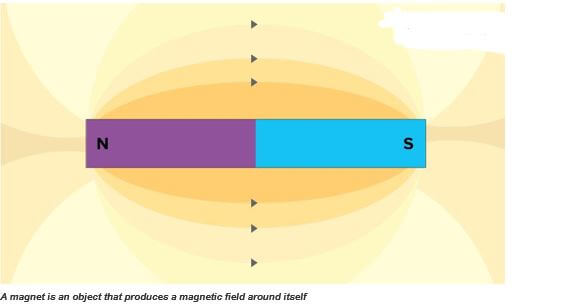
Magnets are classified into two groups natural and artificial magnets based on how they achieved their magnetism and for how long they retain their magnetic abilities and on their magnetic field. Natural magnets occur in nature and are much weaker than artificial magnets.
Natural magnets – Natural magnets occur in nature and have a weak magnetic field. Lodestones are a common example of natural magnets.
Artificial magnets – Artificial magnets can be produced by man-made means and have a stronger magnetic field. They can also be shaped as required. When an artificial magnet is shaped in the form of a bar, it is called a bar magnet.
Properties of Bar Magnet
A bar magnet has properties similar to any permanent magnet.
It has a north pole and a south pole at two ends. Even if you break a bar magnet from the middle, both the pieces will still have a north pole and a south pole, no matter how many pieces you break it in.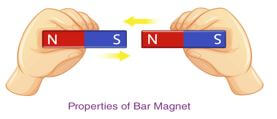
- Its magnetic force of it is the strongest at the poles.
- If this magnet is suspended freely in the air with a thread, it will not come to rest until the poles are aligned in a north-south position. A Mariner’s Compass uses this property to determine direction.
- If two bar magnets are placed close to each other, their unlike poles will attract and like poles will repel each other.
- A bar magnet will attract all ferromagnetic materials such as iron, nickel and cobalt.
The magnetic force between two moving charges may be described as the effect exerted upon either charge by a magnetic field created by the other.
Magnetic and non-magnetic materials
Substances that are attracted by a magnet are called magnetic substances. Example: Iron, cobalt, nickel, etc.
Substances that are not attracted by a magnet are called non-magnetic materials. Example: Aluminium, copper, wood, etc.
Force between like and unlike poles of a magnet
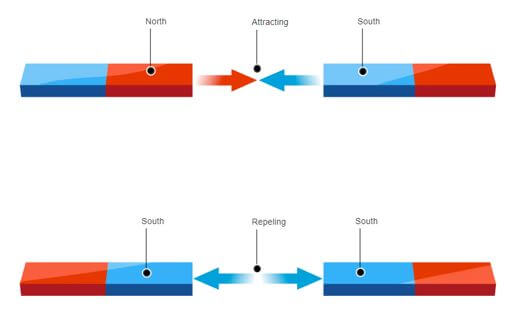
Uses of a magnet
Various Applications and Uses of Magnets
- We might be using computers in our day-to-day lives but never wondered about the presence of a magnet inside it. Magnetic elements on a hard disk help to represent computer data, which is later ‘read’ by the computer to extract information.
- Magnets are used inside TVs, sound speakers and radios. The small coil of wire and a magnet inside a speaker transforms the electronic signal to sound vibrations.
- Magnets are used inside a generator to transform mechanical energy into electrical energy. In contrast, other kinds of motors use magnets to change electrical energy to mechanical energy.
- Electrically charged magnets can help cranes to move large metal pieces.
- Magnets are used in filtering machines that separate metallic ores from crushed rocks.
- It is also used in food processing industries for separating small metallic pieces from grains etc.
- Magnets are used in MRI machines which are used to create an image of the bone structure, organs, and tissues. Even magnets are used to cure cancer.
- At home, you use magnets when you stick a paper on the refrigerator in order to remember something. Attaching a magnetic bottle opener to the fridge can come in handy.
- We often use pocket a compass to find out directions when we are on a trek. The pocket compass uses a magnetic needle to point north.
- The dark strip on the back of debit and credit cards is magnetic and is used to store data like computers’ hard drives.
- Magnets can help collect all the nails which are scattered on the ground after a repair job.
Download Force and Energy - Grade 7 Integrated Science Revision Notes.
Tap Here to Download for 30/-
Get on WhatsApp for 30/-
Why download?
- ✔ To read offline at any time.
- ✔ To Print at your convenience
- ✔ Share Easily with Friends / Students

